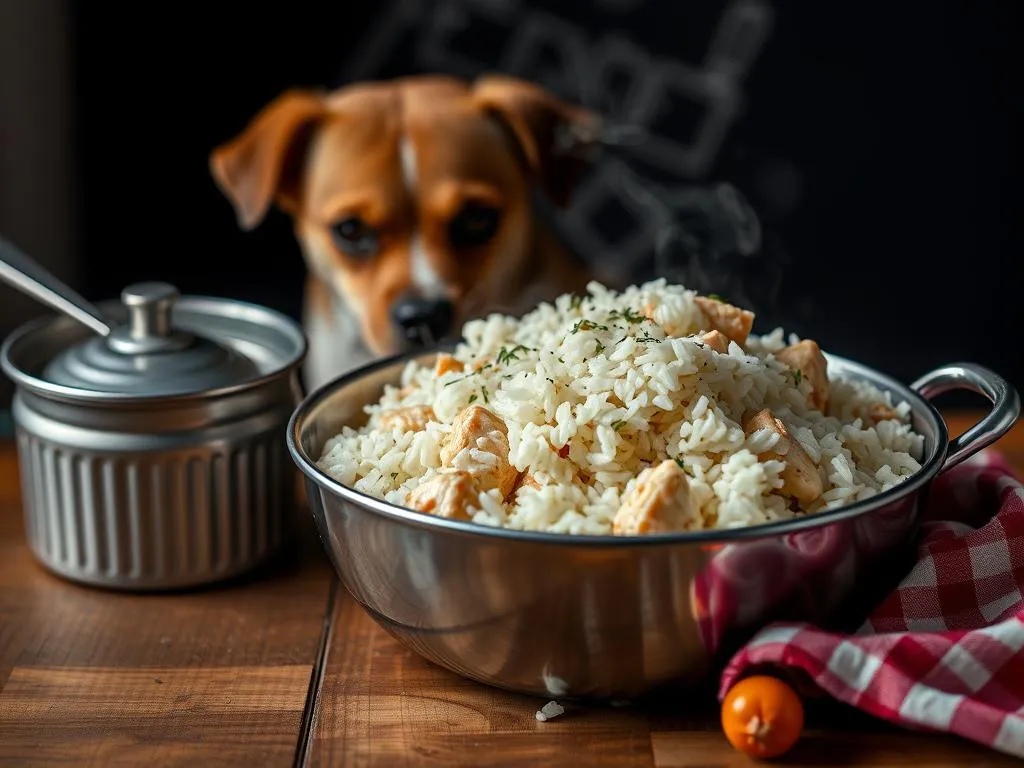
Introduction
When it comes to dog nutrition, understanding what our furry friends need is crucial for their overall health and well-being. Many dog owners opt for commercial dog food, but it’s essential to recognize that not all dog foods are created equal. Some may lack vital nutrients, while others might contain fillers that don’t contribute to a balanced diet. This is where home-cooked meals, like chicken and rice, come into play.
Preparing chicken and rice for dogs is a common and effective way to ensure they receive a nutritious meal that is both wholesome and easy to digest. This combination is particularly beneficial for dogs recovering from illness or suffering from digestive issues. In this article, we will provide a comprehensive guide on how to cook chicken and rice for dogs, including nutritional insights, cooking instructions, and tips for a balanced diet.
Understanding Dog Nutrition
Importance of Proper Nutrition
Proper nutrition is the foundation of a dog’s health. A well-balanced diet can prevent obesity, promote a healthy coat, and support strong bones and teeth. Unfortunately, many commercial dog foods contain low-quality ingredients and fillers, which can lead to nutritional deficiencies over time. By cooking at home, you can control what goes into your dog’s meals, ensuring they receive the nutrients they need.
Key Nutrients for Dogs
To create a balanced diet for your dog, it’s important to understand the key nutrients they require:
- Proteins: Proteins are essential for muscle development and repair. High-quality protein sources include chicken, beef, and fish.
- Carbohydrates: Carbs provide energy and aid in digestion. Good sources include rice, oats, and sweet potatoes.
- Fats: Essential fatty acids support skin health and coat condition. Sources include fish oil and flaxseed oil.
- Vitamins and Minerals: These are crucial for various bodily functions, including immune support and bone health.
Why Chicken and Rice?
Benefits of Chicken and Rice
Chicken and rice is a popular choice for dog owners due to its numerous benefits:
- Easily Digestible Protein Source: Chicken is a lean meat that provides high-quality protein, making it gentle on the stomach.
- Gentle on the Stomach: This meal is ideal for dogs with dietary sensitivities or those recovering from gastrointestinal issues.
- Balanced Meal: When prepared correctly, chicken and rice make a complete meal that offers a good balance of protein and carbohydrates.
When to Feed Chicken and Rice
While chicken and rice can be a staple in your dog’s diet, it is particularly recommended in certain situations:
- Recovery from Illness: After surgery or a bout of diarrhea, this meal can help settle your dog’s stomach.
- Short-Term Diet: It’s best used as a temporary solution. Long-term feeding of chicken and rice alone may lead to nutritional deficiencies.
Ingredients for Cooking Chicken and Rice
Choosing the Right Chicken
When preparing chicken and rice for dogs, the type of chicken you select is essential. Here are some tips:
- Types of Chicken: Opt for boneless, skinless chicken breasts for a leaner option that’s easier to digest.
- Quality Sources: Look for organic chicken or chicken sourced from local farms to ensure you’re giving your dog the best quality protein.
Selecting Rice
Not all rice is created equal when it comes to your dog’s diet. Consider the following:
- Types of Rice: White rice is generally recommended for digestive issues due to its high digestibility, while brown rice offers more fiber and nutrients.
- Nutritional Differences: Brown rice has a higher fiber content, which can be beneficial for regular digestion, but it may not be as easily digestible for dogs with upset stomachs.
Optional Additives
To enhance the nutritional value of your chicken and rice dish, consider adding safe vegetables and supplements:
- Vegetables: Carrots and peas are great options that add vitamins and minerals.
- Supplements: Fish oil can provide essential fatty acids, while probiotics can support gut health.
Step-by-Step Guide to Cooking Chicken and Rice for Dogs
Preparation of Ingredients
Before diving into cooking, it’s important to prepare your ingredients properly:
- Cleaning and Cutting Chicken: Rinse the chicken under cold water and trim any excess fat. Cut it into small, bite-sized pieces to ensure it’s easy for your dog to eat.
- Measuring Rice: Measure out the rice according to the recipe or your dog’s dietary needs. A common ratio is one part rice to one part chicken.
Cooking Instructions
Now that your ingredients are ready, here’s how to cook chicken and rice for dogs:
- Step 1: Boiling the Chicken:
- Place the chicken pieces in a pot and cover them with water.
- Bring the water to a boil, then reduce to a simmer.
-
Cook for about 20 minutes or until the chicken is fully cooked (internal temperature of 165°F or 74°C).
-
Step 2: Cooking the Rice:
- In a separate pot, add water according to the rice package instructions and bring it to a boil.
-
Add the rice, reduce to a simmer, and cover. Cook until the rice is tender (usually around 15-20 minutes for white rice; longer for brown rice).
-
Step 3: Combining Ingredients and Optional Add-Ins:
- Once both the chicken and rice are cooked, shred the chicken into small pieces.
- Mix the chicken and rice together in a bowl. If using vegetables or supplements, add them at this stage.
Portion Control and Serving
Portion control is vital to ensure your dog maintains a healthy weight:
- Recommended Serving Sizes: The amount of chicken and rice you serve should depend on your dog’s size and weight. A general guideline is:
- Small dogs (under 20 lbs): 1/2 cup of the mixture per meal.
- Medium dogs (20-50 lbs): 1 to 1.5 cups per meal.
-
Large dogs (over 50 lbs): 2 to 3 cups per meal.
-
Storing Leftovers: Any leftovers can be stored in the refrigerator for up to three days. You can also freeze portions for later use.
Common Mistakes to Avoid
Using Seasonings and Additives
A common mistake is adding seasonings or ingredients that can be harmful to dogs. Avoid:
- Onions and Garlic: Both can be toxic to dogs, leading to anemia.
- Salt: Excess salt can lead to health issues, including sodium ion poisoning.
Incorrect Cooking Times
Proper cooking times are crucial to ensure food safety:
- Ensure the chicken is fully cooked to an internal temperature of 165°F to avoid potential bacteria like Salmonella.
Neglecting Balance
While chicken and rice provide essential nutrients, it’s important to ensure that your dog’s overall diet is balanced over time. This meal should not be the sole component of your dog’s diet in the long run.
Alternatives to Chicken and Rice
Other Protein Sources
If your dog has allergies or sensitivities to chicken, consider these alternatives:
- Turkey: A lean protein that is often well-tolerated.
- Fish: Salmon or whitefish can provide essential fatty acids.
- Beef: Ground beef can be a tasty alternative, but ensure it’s lean.
Alternative Carbohydrates
In addition to rice, you can include other carbohydrates:
- Sweet Potatoes: Rich in fiber and vitamins, they are a great addition to your dog’s diet.
- Quinoa: A complete protein source that is gluten-free.
- Oatmeal: This is another easily digestible carbohydrate option.
Complete Meal Ideas
To create a more balanced meal plan, mix and match different proteins and grains:
- Chicken with Sweet Potatoes and Carrots
- Turkey with Quinoa and Green Beans
- Fish with Brown Rice and Peas
Conclusion
In summary, cooking chicken and rice for dogs provides an excellent way to nourish your canine companion with wholesome, easily digestible ingredients. This meal can be particularly beneficial for dogs recovering from illness or experiencing digestive issues. By considering homemade meals, you can ensure your dog leads a healthier, happier life.
Experimenting with different recipes and ingredients can keep mealtime exciting for your dog. Remember, always consult with your veterinarian before making significant changes to your dog’s diet to ensure you meet their specific nutritional needs.
FAQs
How often can I feed my dog chicken and rice?
Chicken and rice can be fed as a short-term solution during recovery or if your dog has digestive issues. For long-term feeding, it’s essential to incorporate a variety of proteins and carbohydrates to ensure a balanced diet.
Can puppies eat chicken and rice?
Yes, puppies can eat chicken and rice, but they may require different proportions and additional nutrients to support their growth. Consult your veterinarian for specific guidance.
What if my dog is allergic to chicken?
If your dog is allergic to chicken, consider alternative protein sources such as turkey, fish, or beef. Always consult with your veterinarian for tailored dietary advice.
How do I know if my dog is allergic or sensitive to certain ingredients?
Signs of allergies may include itching, gastrointestinal upset, or ear infections. If you suspect an allergy, consult your veterinarian, who may recommend an elimination diet to identify the culprit.









